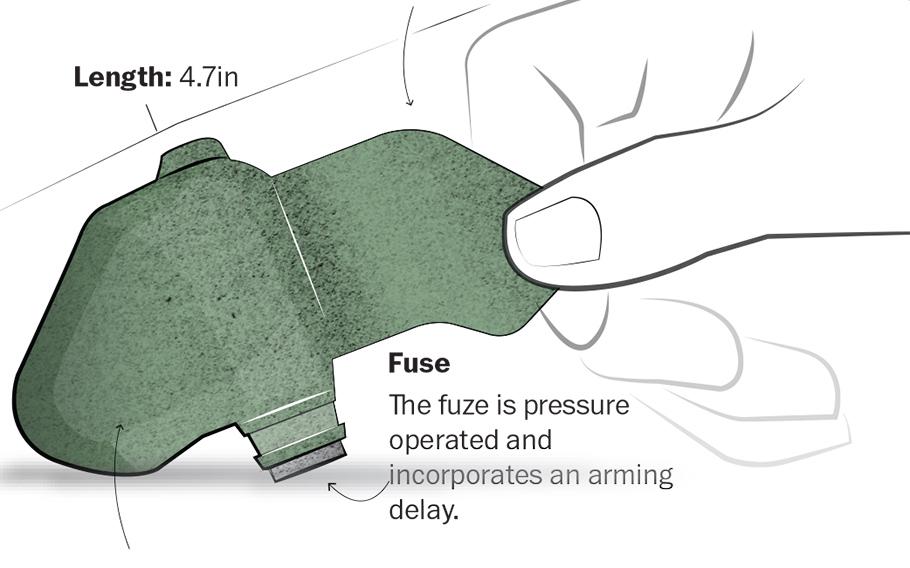Europe
Evidence mounts for use of banned mines by Ukrainian forces, rights group says
The Washington Post June 30, 2023

(The Washington Post)
Ukrainian forces appear to have used rockets to scatter stacks of internationally banned, hand-size antipersonnel land mines over Russian-occupied areas in eastern Ukraine, according to evidence collected by Human Rights Watch.
A report released overnight adds to previous evidence collected by the New York-based rights group suggesting that Ukrainian forces scattered thousands of antipersonnel mines last year, injuring civilians, in violation of the 1997 Mine Ban Treaty, to which Ukraine is a signatory. Russia, which has not signed the treaty, has used antipersonnel mines far more extensively, rights groups say.
The bodyweight-triggered mines in question are considered particularly pernicious and violate international laws of war because they harm soldiers and civilians indiscriminately. Their small size and innocuous appearance can lead to children or other civilians handling them unknowingly.
The rights group examined photographs of the remains of rockets found in eastern Ukraine that are used exclusively to scatter PFM-1S antipersonnel mines. Handwritten messages on the remains could be traced back to Ukrainian organizations that offered to have "death wishes" inscribed on various munitions to raise funds for the war effort.
Russian forces have made use of at least 13 different types of banned antipersonnel mines, as well as victim-activated booby traps, in the invasion of Ukraine, Human Rights Watch found in previous reports. But Ukraine has expressly committed not to use them, despite evidence suggesting the contrary.
"These antipersonnel mines have had immediate and devastating consequences for civilians in and around Izium, including by tearing off limbs of residents as they go about their daily lives," said Ida Sawyer, the director of Human Rights Watch's crisis and conflict division.
The Ukrainian government has not responded to requests for comment on the apparent remains of Ukrainian rockets used to scatter mines, but acknowledged previous findings by the rights group, saying they would be "duly studied."
"Ukraine, exercising its right to self-defense in accordance with Article 51 of the U.N. Charter, fully implements its international obligations while Russian occupiers commit the war crimes, crimes against humanity and genocide of the Ukrainian people," the Foreign Ministry said in its response earlier this year.
Known as butterfly or petal mines for their shape, small size and light weight, PFM mines are typically green or brown, and one wing is filled with explosives meant to detonate when enough pressure, between 11-55lbs, is applied.
Though some types of PFMs can be emplaced by hand, PFM-1S variant must be deployed using a mine-laying system from a mortar, aircraft or rocket such as the Uragan 9M27K3 mine-laying rocket identified in the report.
Such rockets can carry 312 mines in stacks of "cassettes" that disperse after the rocket is fired.
PFM-1S mines, which can float down to the ground without detonating, are equipped with a mechanism that is designed to self-destruct between 1-40 hours after deployment.
When that mechanism fails, which it often does, the mines threaten civilians by remaining undetonated on the ground indefinitely.
The 1997 Mine Ban Treaty, to which the United States, like Russia, is not a party, requires countries to abstain from using antipersonnel mines and get rid of any stores they may have, a process that can be costly.
Russia's rejection of the treaty does not exempt it from accountability, Sawyer said, as any use of "inherently indiscriminate weapons" violates international law.
Though Ukraine ratified the treaty in 2005 and officials reported the destruction of millions of antipersonnel mines, in 2021 the country reportedly still possessed more than 3 million.
Any use of mines contributes to an arduous process for returning Ukraine's land to civilian use. Demining is a slow, costly enterprise that experts say could take as many as hundreds of years.
Since Ukraine regained control of the territory around Izyum, Sawyer said, a new round of mine injuries have been reported. "Because of the nature of these mines," Sawyer said, "civilians will likely suffer for many years to come."
The Washington Post's David Stern contributed to this report.